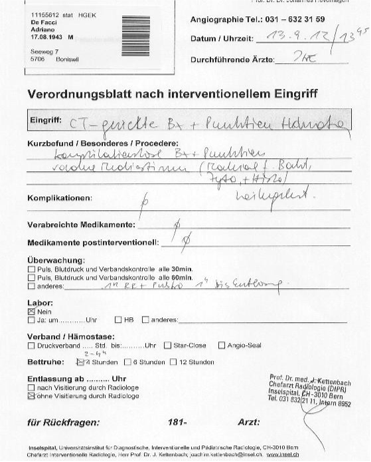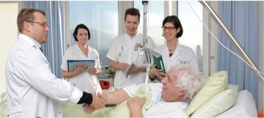术后护理(Procedure care)
卧床休息2小时 Bed rest for 2 hours
-
拔肺活检穿刺针后,患者穿刺侧向下卧位 following removal of needle, position pat. with biopsy side down
不鼓励说话,移动和咳嗽 Discourage talking, moving, and coughing
-
减少可能导致气胸的胸腔内压力 to minimize intra-thoracic pressure that could result in pneumothorax.
活检操作报告 Include preliminary report
-
当病人回病房的时候 when patient is moved back to ward
胸片 Chest film
-
如果小气胸已经存在,2小时候拍胸片;如果气胸<30%,2小时重复胸片in 2h if small pneumo-thorax already present, repeat in 2h if < 30%.
-
至少活检后除外渗出和严重出血 4小时At least in 4 hours post bx to rule out effusion/severe bleeding
出院 Discharge patient from ward


Post Procedure After blood patch placement and needle removal, some physicians roll the patient into the puncture-site-down position.
活检完成和拔针后,一些医生愿意将患者穿刺部位下位。主要是希望限制穿刺一侧的肺活动。
This initial repositioning event should be performed by as many assistants as necessary to ensure that the patient remains passive and does not strain or perform a Valsalva maneuver.
换体位的事应由尽可能多的助手执行,以确保患者保持被动,不会紧张或执行Valsalva 呼吸。
A forceful Valsalva maneuver is less likely to occur if the roll is performed while the patient lets his or her breath out.
如果在病人屏住呼吸的同时才进行翻滚手术,就不会发生强有力的Valsalva呼吸。
The needle removal and the rolling should take no more than a few seconds.
拔针和翻身的时间都不要超过几秒钟。
Puncture-site-down positioning was first suggested by Zidulka in 1982.
It may work from a physiologic and/or mechanical mechanism.
它可能从一种生理和/或机械机制中发挥作用。
Physiologically, it makes the periphery of the dependent lung atelectatic, which should reduce local aeration.
生理上,它使依赖性肺的周围发育不张,这应该会减少局部通气。【作者的语气也不肯定】
从理论上讲,防止所有可能提高胸内压力的活动都是有益的,比如任何需要使用辅助肌肉的呼吸(例如,大笑)或紧张(例如,坐在床上没有帮助)。
应监测血氧饱和度。补充氧气干扰了随访跟踪小气胸对临床影响,因此它只应在必要时使用。如果已知存在气胸,可以使用氧气以促进现有气胸的吸收。这可能有帮助的前提是,较高的氧气分压加速了被捕获的胸膜空气的扩散吸收,而胸膜空气主要由氮(和二氧化碳)组成。
影像随访(follow-up Imaging)
除非有症状或血氧饱和度下降提示存在气胸,否则活检后无需立即获得胸片。但实际情况是做完活检拔针后操作者都会重复CT扫描以观察是否出现气胸。如果气胸不严重,观察后再离开医院,观察时间由操作者自行确定,并无固定时间。
另一方面,如果最初确实存在亚临床问题,最好在出院前知道它。在门诊开展活检穿刺的情况下有些事是做不到的。如在穿刺位置几个小时后,病人应该恢复常规的活动。然后进行胸部x光检查。至少两个视图(如前后位和斜位)的站立呼气图像提供了通过平片检测胸膜间空气最敏感的方法。在没有连续图像的情况下,无法区分新的或持续的泄漏与手术后立即发生的、然后停止的泄漏。因此,在最初发现气胸后应进行随访成像,以确定泄漏的稳定性。
患者离院 (Patient Discharge)
穿刺活检后决定让病人离院,而不是入院接受观察或治疗,取决于病人的病情、家庭情况和家庭位置。如果有超过轻微的气胸或轻微的身体症状或体征,则考虑到死亡风险较小的张力性气胸,只有以下患者可以出院:
-
能忍受小气胸,
-
有一个负责任的家庭成员来和病人在一起过夜,以及
-
住在症状出现后10至15分钟内被送往医疗设施或救护车到达的范围内。
| 